The week at a glance
- Madeiran Storm-petrel off the Cornish coast
- Zitting Cisticolas in Kent and Jersey
- Little Crake in Dorset
- Pallid Harrier in Cambridgeshire
- American Black Tern still in Oxfordshire
- Possible Yelkouan Shearwater in Cornwall
- Possible Sharp-tailed Sandpiper in Fife
- Influx of Glossy Ibises continues
There was another rather impressive haul of birds this week: from the scare to the rare and on and on, right the way through to a bird right out of the very top drawer. A topsy-turvy mix of early autumnal conditions brought downpours and flooding to some parts of Scotland, and strong Atlantic winds ensured more excellent seawatching in southwest England and on the Irish west coast. Then, as the review period came towards a close, temperatures began to nudge slightly above the seasonal norm in parts of the southeast of England.
September 3rd, for birders of a certain age, will always be lodged in the memory banks as a day (in 1983) that produced one of the most famous seawatches of all time, off the Cornish coast at St. Ives. The undoubted highlight was a Wilson's Storm-petrel (a genuine mega 26 years ago) and a wreck of Sabine's Gulls in and around the harbour and nearby Carbis Bay. Now, for some, September 3rd 2009 will be another seawatching day that will always be unforgettable. The species this time around? Madeiran Storm-petrel. The bird was watched for just under 10 minutes flying west from Pendeen Watch (Cornwall), coming in to around 500 metres offshore, as it headed past 14 observers in perfect early evening light. The full "suite of characters" was noted and all that is left now is for the 10 men of the BBRC to take a collective view from their (metaphorical) armchairs to see what they think. This Madeiran Storm-petrel comes hot on the heels of a "probable" seen off Pendeen early this autumn (on August 20th), and another Madeiran Storm-petrel is in circulation from Pendeen, seen on 16th September 2007 (that bird was on view, off and on, for 45 minutes). One local observer has seen all three birds, and several birders present this week also saw the 2007 bird (the 2009 bird was closer and offered better views). Ahead of the trio of Pendeen sightings is the record of one seen (and photographed) from a Scillonian pelagic on 28th July 2007, now rumoured to be at the BOURC stage. The only accepted records of Madeiran Storm-petrel are from Blackrock Lighthouse in County Mayo (a dead bird picked up there in October 1931) and another corpse picked up in Hampshire in November 1911.
A Zitting Cisticola was at Pegwell Bay (Kent) briefly on 6th, showing again on 7th and performing well from time to time on 8th (this was the second, or even third, record of the species in the county in six weeks or so). Meanwhile on Jersey one was noted again at Noirmont Point on 5th (one was seen at the same site on 31st August). In Dorset, a Little Crake was found at Radipole Lake on 5th, the first in the county since a juvenile/first-winter bird photographed at Stanpit Marsh in August 1994. The species has now been recorded in the past three years, though each of these has seen just one bird apiece (this year's Dorset bird, last year saw one being well twitched in Devon and in 2007 a photogenic male was on Shetland). In Cambridgeshire, a probable Pallid Harrier at Long Drove near Haddenham on the afternoon of 6th remained to the following day, when the identification was confirmed and the "probable" became a super near-adult male (and a county first to boot). The bird remained until 9th (albeit rather elusive).
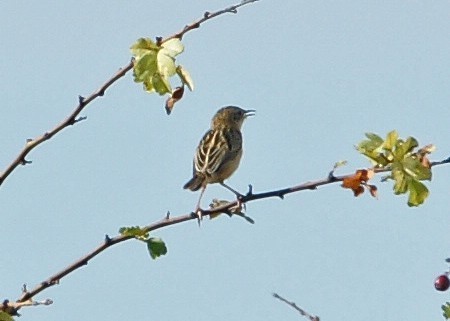
Zitting Cisticola, Pegwell Bay, Kent (Photo: Steve Ray)

Pallid Harrier, Haddenham, Cambridgeshire (Photo: Richard Bayldon)
In Oxfordshire, the well-received juvenile American Black Tern remained at Farmoor Reservoir (along with the juvenile White-winged Black Tern and Black Tern) until the evening of 3rd, with well over 1,000 birders heading along the causeway to enjoy this unique threesome. Back in Cornwall, another possible Yelkouan Shearwater flew past Pendeen on 3rd (with what may have been another there on 4th), while a possible Sharp-tailed Sandpiper was reported from Guardbridge (Fife), also on 3rd.
As exciting as an identifiable Madeiran Storm-petrel may be, the highlight of the week for many has to be the continuing invasion of Glossy Ibis. After the flock of 12 (at least two of which were colour-ringed) in Wexford last week, the new review period began with a single bird at Kidwelly (Carmarthenshire) on 3rd (the first county record for a year shy of a century). Then on 4th, and still in Carmarthenshire, came the amazing news of a flock of 25 birds at Pembrey, 16 of which flew off during the middle of the morning. By the afternoon, 10 birds were still present and they remained until 6th at least (with four of them bearing colour-rings — currently thought to be from a French scheme). A flock of five "probables" was seen flying over Cardiff (Glamorgan) later on 4th and on 5th, a group of eight juveniles was found at Tacumshin (Co. Wexford) and seven flew over Canvey Island (Essex). On 4th, a single bird was at St. Nicholas-at-Wade (Kent) and by 6th what may have been the same lone juvenile was at Stodmarsh (Kent), a rather fitting location given just how many birders paid homage to the long-staying birds there during the late 1970s to the start of the 1990s. Also on 6th, a Glossy Ibis arrived at Chew Valley Lake (Somerset) and another was seen flying over Baglan Bay (Glamorgan). What may have been the "Canvey Island 7" were seen in flight at Sutton Gault (Cambridgeshire) on 7th and on 8th, another was at Hen Reedbeds (Suffolk). Also on 8th, three further probables were seen flying over Thursley Common (Surrey).

Glossy Ibis, Tacumshin, Wexford (Photo: Tom Shevlin)
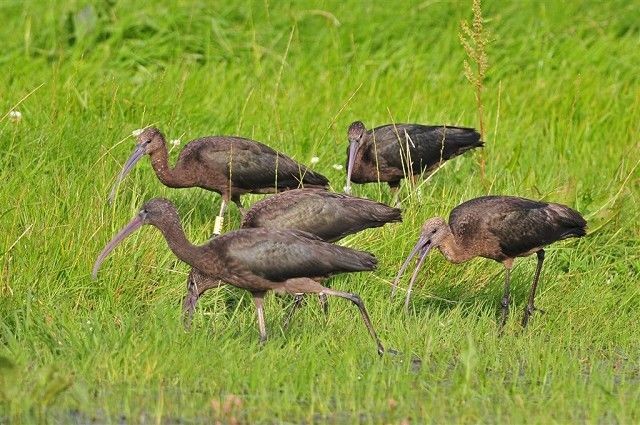
Glossy Ibis, Burry Port, Carmarthen (Photo: Julian)
At Pendeen, a single Wilson's Storm-petrel celebrated the 26-year St. Ives Island anniversary with an early-morning flypast on 3rd, when one was also seen off Bridges of Ross (Co. Clare). The pick of the Wilson's this week though was the bird seen off Seaforth (Lancashire/North Merseyside) on 5th. A county first, the bird was seen for 10 minutes or so before heading out into the mouth of the Mersey. Later in the day, what may have been the same bird was reported from Crosby beach, but here it never went beyond "probable" status.
Around 25 Cory's Shearwaters were noted during the week including, on 3rd, six off Kilcummin Head (Co. Mayo) and four or five from Pendeen (one of which had the air of a Scopoli's about it). On 4th, a single bird was seen off Spurn (East Yorkshire) and on 5th single birds were seen off the coasts of East Yorkshire, Northumberland, Borders and Fife (could it be just the one bird?). Also on 5th, a Cory's was seen from Thorpeness (Suffolk), while on 6th a single bird was seen from Flamborough Head (East Yorkshire). A Great Shearwater was also seen off Flamborough this week, noted from an RSPB cruise on 5th. A dozen were seen from Kilcummin Head on 4th, when one was noted off Holme (Norfolk) and on 9th one flew past Labost, Lewis (Outer Hebrides). Very few others were recorded but the Pendeen seawatchers popped one onto the impressive list for the 3rd. Some 500 or so Balearic Shearwaters were counted countrywide this week, with around 70 off Pendeen on 4th the highest single day total. Forty were counted there the previous day, and 20 were off Portland, also on 3rd. There were no four-figure counts for Sooty Shearwaters this week, counts of 100 (on 3rd) and 80 (on 4th) from Kilcummin Head being the largest counts of the week.

Sooty Shearwater, South Shields, Durham (Photo: Mark Newsome)

Manx Shearwater, Draycote Water, Warwickshire (Photo: Steve Valentine)
Sabine's Gulls comfortably hit three figures this week: several birds were strewn along the coast of northwest England over the weekend, while Pendeen bagged five birds on 4th. Strumble Head in Pembrokeshire managed six on 5th while 19 were counted at Kilcummin Head on 3rd, with 11 there the following day. At Bridges of Ross in County Clare, 13 Sabine's were seen on 8th. The second-summer remained at Upton Warren (Worcestershire) into the early part of the week.

Sabine's Gull, Hoylake, Cheshire (Photo: Marcus Conway)

Sabine's Gull, New Brighton, Cheshire (Photo: David Mason)
East Anglia dominated Long-tailed Skua numbers this week. Up to 20 birds were recorded around Norfolk and Suffolk, including six birds off Ness Point, Lowestoft (Suffolk) on 5th and four reported from Cley (Norfolk) the same day. Several singles were noted elsewhere around Britain and Ireland, but failed to muster more than double figures in total. Up to 30 Pomarine Skuas included five off Fife Ness in Scotland. Grey Phalaropes mustered around 80 birds, most of them from Pendeen — at least 30 on 3rd (including a flock of 18) and 27 on 4th. A juvenile Red-necked Phalarope flew along the shoreline at Heswall (Cheshire) on 3rd, while a report of three Little Auks off Holme felt a little unseasonable on 9th.

Grey Phalarope, St. Ouen's Pond, Jersey (Photo: Mick Dryden)
Single Cattle Egrets remained at Keyhaven Marshes (Hampshire) and Frampton-on-Severn (Gloucestershire) for much of the week. In Kent, a second Great White Egret was seen flying in off the sea at Dungeness on 6th (the original bird remained on nearby Denge Marsh) while another long-staying bird remained at Chard Reservoir (Somerset) for much of the week. Two Great White Egrets were still at Over Fen (Cambridgeshire) on 6th, while in Leicestershire a Great White Egret was at Saddington Reservoir from 3rd–7th. A flock of 17 Spoonbills was out on Orford Ness (Suffolk) on 6th, six were at Cley Marshes (Norfolk) from 4th, and four were again in Poole Harbour (Dorset). In the Norfolk Broads, 24 Common Cranes were seen at Brograve Farm on 3rd and 33 were at the Stubb Mill roost on 7th. In Shropshire, a juvenile Purple Heron was near Rednal on 4th–9th and another youngster arrived at Saltholme Pools (Cleveland) on 7th (moving to Dorman's Pool later the same day). On Jersey, an adult and juvenile Night Heron were found at St. Ouen's Pond on 4th. On the Isle of Man, the White Stork was still around, seen at Port St. Mary on 9th.

Cattle Egret, Keyhaven Marshes, Hampshire (Photo: Simon Johnson)
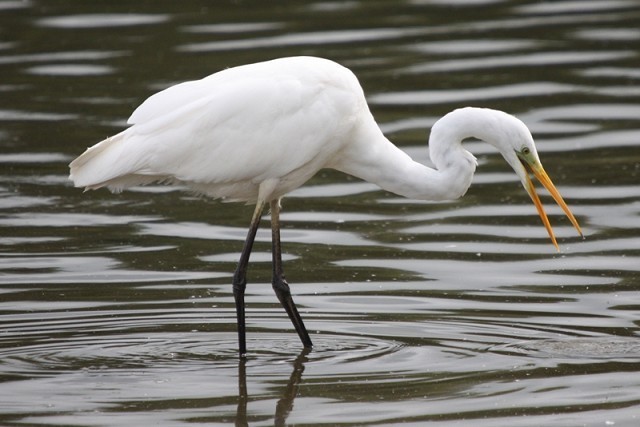
Great White Egret, Chard Reservoir, Somerset & Bristol (Photo: Steve Carey)
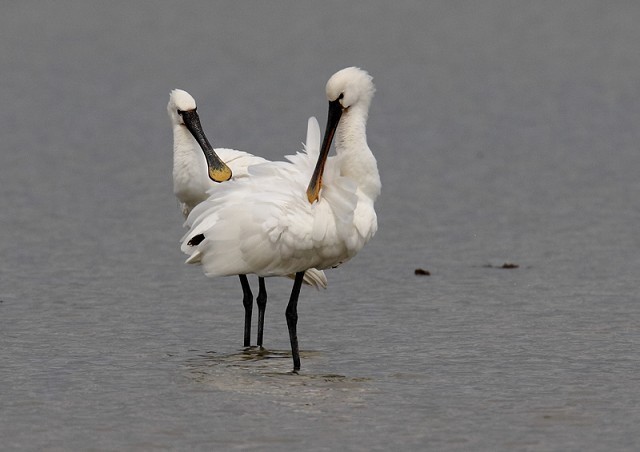
Spoonbill, Cley Marshes NWT, Norfolk (Photo: Mick Green)

Purple Heron, Rednal, Shropshire (Photo: Dave Western)
After an impressive showing in the last couple of weeks, there were six Spotted Crakes on offer this week: singles remained at Marazion Marsh and the Walmsley Sanctuary (Cornwall) and Greylake (Somerset), while new birds were found at Grafham Water (Cambridgeshire) on 3rd and Dungeness on 6th. Another was seen in the Dearne Valley (South Yorkshire) on 8th. On Scilly, a Corncrake was seen on St. Mary's on 3rd.

Spotted Crake, Greylake RSPB, Somerset & Bristol (Photo: Chris Grady)
A presumed eclipse drake Blue-winged Teal was reported from Frampton Marsh (Lincolnshire) on 4th. A drake Ferruginous Duck was found at Pitsford Reservoir (Northamptonshire) on 6th and the presumed Ring-necked Duck at Westport Lake (Staffordshire) was present to 8th at least. Another drake Ring-necked Duck was found at Carrowmore Lake (Co. Mayo) on 6th. Further north, some belated news from Shetland this week: the drake Lesser Scaup was again on Loch Benston on 24th August. A drake Surf Scoter was seen from Carnoustie (Angus) on 4th–5th but much more of a surprise was the discovery of an eclipse drake King Eider at the mouth of the River Witham (Lincolnshire) on 5th. The bird reappeared the following day off Freiston Shore and was back at the Witham later the same day, to the delight of every Lincolnshire lister — this was a county first after all. The bird remained to 9th. In Cleveland, the adult female Hooded Merganser remained at Port Clarence from 3rd–8th. On 31st August, a Snow Goose was seen briefly with Greylag Geese at Craobh Haven (Argyll).
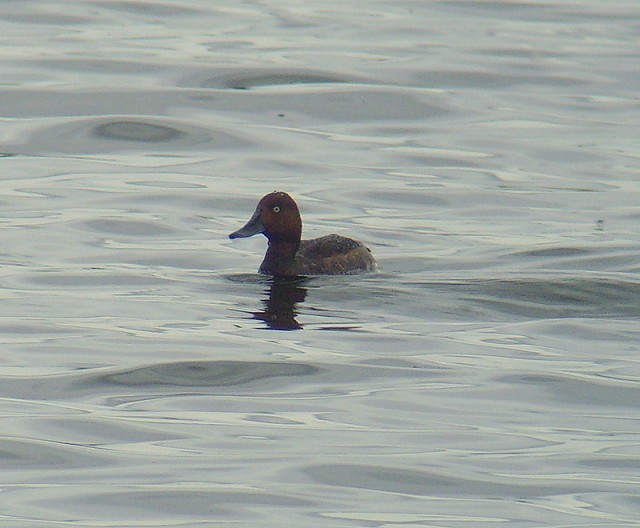
Ferruginous Duck, Loch Gelly, Fife (Photo: John Nadin)

King Eider, Freiston Shore RSPB, Lincolnshire (Photo: Russell Hayes)
The adult female Snowy Owl was still at Termon Hill, Blacksod Bay (Co. Mayo) to 7th and a Black Kite flew over Marazion Marsh and Crowlas (Cornwall) on 9th. Aside from a few migrant Honey Buzzards and Montagu's Harriers, these were the only birds of prey of note this week (although an eagle sp. reported flying towards Lincolnshire from Holme on 9th could have caused a stir if it could have been identified for certain.)

Honey Buzzard, Brading Marshes RSPB, Isle of Wight (Photo: Graham Sparshott)
A new juvenile Spotted Sandpiper was found at Nethertown (Co. Wexford) from 5th and a juvenile Long-billed Dowitcher was a new arrival at Doonbeg (Co. Clare) on 7th. It's been a good week for Baird's Sandpipers — up to six birds were noted, including two each for Cornwall and County Kerry. The Irish birds, at Black Rock Strand and Carrahane, were remnants from last week, while one of the Cornish juveniles, at Davidstow, appeared on 2nd, with news circulating from 3rd, when one was found at Marazion. On 4th, a juvenile was found at Traeth Dulas (Anglesey), this bird still present to 9th, while the final bird of the sextet was seen on North Uist on 6th. Back in Kerry, the juvenile Semipalmated Sandpiper was still at Smerwick Harbour to 9th (along with a Buff-breasted Sandpiper there on 3rd) while another "Semi-P" was seen on White's Marsh (Co. Cork), also on 3rd. Further Buff-breasted Sandpipers were at Griminish and Loch Borinish, South Uist (Outer Hebrides) on 7th and 9th, with another "Hebs" bird appearing at Butt of Lewis on 8th (and three further possibles past there on 9th). Two birds were on St. Mary's (Scilly) on 9th, with two more on the Cornish mainland, at Polgigga, the same day. Other singles found on 9th were seen on Tiree (Argyll) and near West Burra (Shetland).

Baird's Sandpiper, Davidstow Airfield, Cornwall (Photo: Gary Thoburn)
American shorebirds left over from last week included adult American Golden Plovers at Bornish, South Uist (Outer Hebrides) — perhaps the same bird seen elsewhere on the island at the end of the week — and Myroe Levels (Co. Derry) with a probable seen over Orkney on 9th. The Wilson's Phalarope found last week at Bowling Green Marsh (Devon) was still present on 3rd, before moving across to Exminster Marshes on 4th–5th (reappearing again on 7th). The adult Lesser Yellowlegs remained at Aberlady Bay (Lothian) to 9th, while at least 13 Pectoral Sandpipers included two on pools near the Butt of Lewis (Outer Hebrides) on 6th. Singles included birds in South Yorkshire, Lincolnshire, Norfolk, Suffolk, Dublin and Wexford. A Dotterel was found on Blakeney Point (Norfolk) on 6th and another was at Freiston Shore on 7th. A Red-necked Phalarope was at Bawdsey (Suffolk) on 9th.

American Golden Plover, Bornish, S.Uist, Outer Hebrides (Photo: Steve)

Pectoral Sandpiper, Old Moor RSPB (Dearne Valley), South Yorkshire (Photo: Brian Irvine)
A second-summer Ring-billed Gull was again at Loe Pool (Cornwall) on 5th and adults were at Westcliff-on-Sea (Essex) on 5th, Black Rock Strand (Co. Kerry) on 6th and Nimmo's Pier (Co. Galway) on 7th. Also on 6th, a first-summer Ring-billed Gull was noted at Quilty (Co. Clare) and a Glaucous Gull was on the Outer Hebrides during the week. Three second-summer Caspian Gulls (one sporting a green colour-ring) were at Blackborough End tip (Norfolk) on 4th (with an adult there on 7th) and an adult and first-summer were at that other well-known cachinnans hotspot — Pitsea tip in Essex — on 5th. A first-summer bird was noted at Paxton Pits (Cambridgeshire) on 6th (with a second-winter — the same bird? — the following day) and another first year was at Bodington Reservoir (Northamptonshire) on 9th. Dublin's Sandymount Strand hosted another impressive roost of Roseate Terns on 7th — over 550 birds were counted.
After another short leave of absence, the juvenile Citrine Wagtail was again at Marazion Marsh on 5th–7th and two Citrines were found in Wexford in the space of 24 hours. A female was at Nethertown on 8th and a juvenile appeared at Churchtown on 8th. Staying in the same county, a probable Tawny Pipit was at Carnsore Point on 5th. Up to 25 Wrynecks included three birds on Fair Isle on 4th, three around Devon between 3rd and 5th and two at Land's End (Cornwall) on 9th. On Scilly, a Golden Oriole was seen on St. Mary's on 9th.

Wryneck, Oxey Marsh, Hampshire (Photo: Mr D H Patterson)
Only four Red-backed Shrikes were reported this week: one remained at Dungeness (Kent), another was at Conwy RSPB on 5th, with further singles appearing near Stromness (Orkney) on 6th and St. Mary's (Scilly) on 9th. A juvenile Woodchat Shrike was found northwest of Wells (Somerset) on 6th and was still present to 8th. An Alpine Swift was found over Aldenham CP (Hertfordshire) on 5th with perhaps the same bird relocating to, firstly, Alexandra Park (London) on 6th and then Pegwell Bay (Kent) on 8th. Another Alpine Swift was seen over King's Lynn (Norfolk) during the evening of 8th.
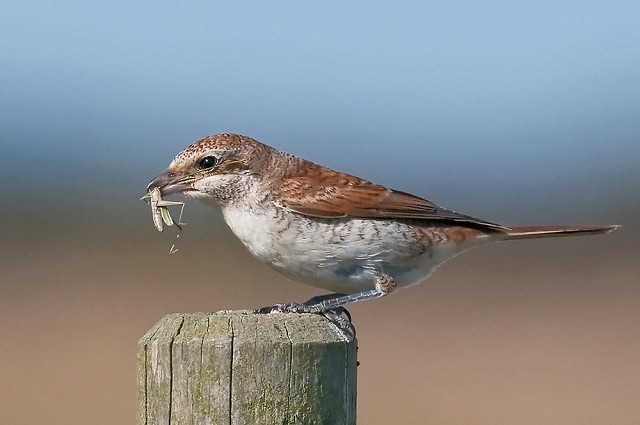
Red-backed Shrike, Dungeness RSPB, Kent (Photo: Howard Kearley)

Woodchat Shrike, Westbury-sub-Mendip, Somerset & Bristol (Photo: James Packer)

Alpine Swift, Alexandra Park, Greater London (Photo: Simon West)
The most intriguing warbler report of the week was the Lanceolated Warbler seen at Fort Island, Langness (Isle of Man) on 9th — a very early record for this classic September vagrant. Two Greenish Warblers were in County Durham this week: one was found at Whitburn Country Park on 5th and was followed by a second bird at Marsden Quarry on 6th. Earlier in the week, on 4th, a Greenish Warbler was found at Loch of Strathbeg (Aberdeenshire). The fourth Greenish of the week was at Hoylake on the Wirral on 6th, and may well have been present since 4th. Single Icterine Warblers this week were noted on the Farne Islands (Northumberland) on 4th, on Fair Isle (Shetland) and at Fife Ness (Fife) on 5th, St. Ives (Cornwall) on 8th and St. Agnes (Scilly) on 9th. Melodious Warblers were on St. Mary's (Scilly), at Land's End (Cornwall) from 5th and on Sherkin Island (Co. Cork) on 8th. Over a dozen Barred Warblers were seen on the Northern Isles this week, with three on North Ronaldsay (Orkney) on 4th leading the way, plus two birds at Norwick on Unst (Shetland) on 6th. A Marsh Warbler was also on Unst this week, seen at Northdale on 5th, while in County Cork a Red-breasted Flycatcher arrived on Cape Clear Island on 7th–9th.
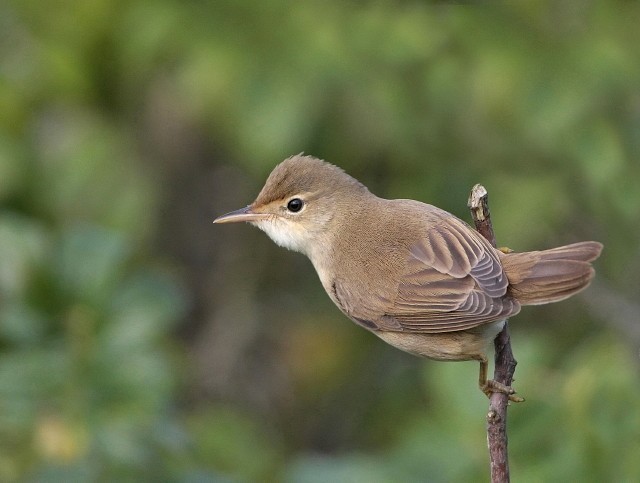
Marsh Warbler, Northdale, Unst, Shetland (Photo: Robbie Brookes)
On the Isle of Wight, the Shore Lark remained at West High Down to 5th at least. The juvenile Rose-coloured Starling remained at Portland (Dorset) to 6th and a second juvenile was found in the county, at Wyke Regis, on 5th. An Ortolan Bunting along the famous East Bank at Cley drew the crowds on 4th–5th with another at Flamborough Head on 5th–7th, and two birds were seen on Portland on 9th. A juvenile Common Rosefinch was at Durlston CP (Dorset) on 4th–5th, with another Dorset bird appearing at Kimmeridge Bay on 6th. Three were on Fair Isle on 6th and further Shetland birds were seen at Baltasound, Unst, also on 6th, and near Fladdabister on 9th.

Ortolan Bunting, Flamborough Head, East Yorkshire (Photo: Sean Johnston)

Lapland Bunting, North Ronaldsay, Orkney (Photo: Paul A Brown)
Photo of the Week

Sparrowhawk, Hampton, Worcestershire (Photo:
Mark Hancox)
Images featuring birds and their reflections always have added appeal, especially when the reflection is sharp. Calm water and a low shooting angle make this type of shot all the more effective. Typically, such shots feature waders, wildfowl or other birds that normally feed in or on water. As an unusual alternative, though, it's possible to get reflection shots of land-based birds as they drink or bathe at a suitable pool. Mark Hancox illustrates this perfectly with his image of a Sparrowhawk that came down to his reflection pool set-up. Be prepared to be patient to get shots like this though: Mark had been visiting this pool regularly for two years before this bird finally came down to bathe.
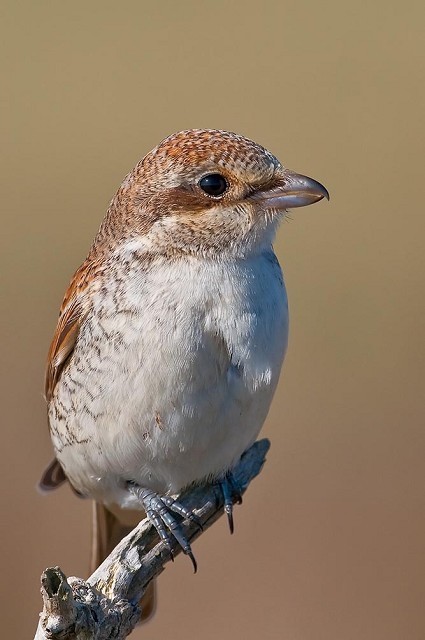
Red-backed Shrike, Dungeness RSPB, Kent (Photo:
Howard Kearley)

Dipper, Llangollen, Clwyd (Photo:
Neill Carden)

Common Kingfisher, Rye Meads RSPB, Hertfordshire (Photo:
Pixellence)

Ringed Plover, Red Rocks, Cheshire (Photo:
David Cookson)

Baird's Sandpiper, Davidstow Airfield, Cornwall (Photo:
Gary Thoburn)
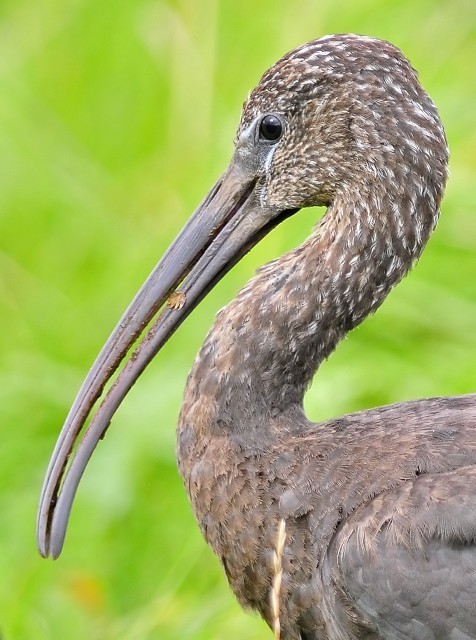
Glossy Ibis, Burry Port, Carmarthen (Photo:
Julian)

Sabine's Gull, Hoylake, Cheshire (Photo:
Steve Round)

Lesser Spotted Woodpecker, undisclosed site, Cheshire (Photo:
Steve Round)

Common Redstart, undisclosed site, Derbyshire (Photo:
Robert Askew)

Marsh Warbler, Northdale, Unst, Shetland (Photo:
Robbie Brookes)

Lesser Whitethroat, Minsmere RSPB, Suffolk (Photo:
Jon Evans)

Night Heron, Czech Republic (Photo:
Honza)

Arctic Skua, Aith, Fetlar, Shetland (Photo:
Dean Eades)

Spotted Redshank, Cley Marshes NWT, Norfolk (Photo:
John Betts)

Cattle Egret, Keyhaven Marshes, Hampshire (Photo:
Simon Johnson)

White-tailed Eagle, Skye, Highland (Photo:
Roy Plenderleith)

